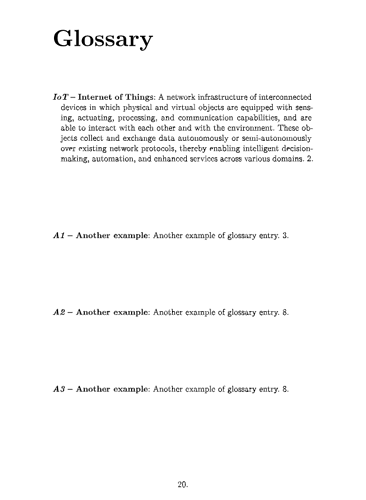As you can see in this example, there is a big white space between glossary entry that I don’t want to be there. I don’t know what causes this, I don’t have particular spacing rules for the glossary or spacings.
If anyone has a clue of what the issue might be, please let me know.
P.S. I’m using Glossarium
Could you share your code? Did you use the term list function or any package? I see your tag glossarium.
Here’s part of the code:
thesis-config.typ
#import "@preview/glossarium:0.5.8": make-glossary, register-glossary, print-glossary, gls, glspl, gls-short, gls-description
#import "@preview/codly:1.3.0": *
#import "@preview/codly-languages:0.1.8": *
#import "../config/constants.typ": chapter, appendix
#import "../appendix/glossary/terms.typ": glossary-terms
// This file sets up the properties of the document and the libraries used
#let config(
myAuthor: "Name",
myTitle: "Title",
myLang: "en",
myNumbering: "1.1",
body,
) = {
set document(author: myAuthor, title: myTitle)
show: make-glossary
register-glossary(glossary-terms)
show: codly-init.with()
codly(languages: codly-languages, zebra-fill: gray.lighten(90%))
set page(margin: 1.75in, numbering: myNumbering, number-align: center)
set par(
leading: 0.55em,
spacing: 0.55em,
justify: true,
)
set text(font: "New Computer Modern", lang: myLang)
set heading(numbering: myNumbering)
show raw: set text(font: "DejaVu Sans Mono", size: 10pt)
set par(spacing: 0.55em)
show heading: set block(above: 2em, below: 1.4em)
show heading.where(level: 1): it => {
stack(
spacing: 2em,
if it.numbering=="A.1"{
text(size: 1.5em)[#appendix #counter(heading).display()]
} else if it.numbering != none {
text(size: 1.5em)[#chapter #counter(heading).display()]
},
text(size: 2em, it.body),
[],
)
}
// Custom styling
set list(marker: (sym.bullet, sym.dash))
set table(inset: 10pt)
set table(
fill: (x, y) => {
if calc.even(y) {
gray.lighten(70%)
} else { white }
}
)
show figure: it => {
v(1em)
it
v(1em)
}
body
}
#let glossary-style(body) = {
text(style: "italic", body)
}
#let gl(key,
suffix: none,
long: false,
display: none,
link: true,
update: true,
capitalize: false
) = glossary-style(
gls(
key,
suffix: suffix,
long: long,
display: display,
link: link,
update: update,
capitalize: capitalize
)
)
#let glpl(
key,
long: false,
link: true,
update: true,
capitalize: false
) = glossary-style(
glspl(
key,
capitalize: capitalize,
link: link,
long: long,
update: update
)
)
#let linkfn(url, body) = (
link(url, text(style: "italic", body))+footnote(link(url))
)
glossary.typ
#import "../../config/constants.typ" : glossary
#import "terms.typ": glossary-terms
#import "../../config/thesis-config.typ": print-glossary
#pagebreak(to:"odd")
#heading(numbering: none, glossary) <glossary>
#print-glossary(glossary-terms, deduplicate-back-references: true)
terms.typ
#let glossary-terms = (
(
key: "iot",
short: [IoT],
long: [Internet of Things],
description: [A network infrastructure of interconnected devices in which physical and virtual objects are equipped with sensing, actuating, processing, and communication capabilities, and are able to interact with each other and with the environment. These objects collect and exchange data autonomously or semi-autonomously over existing network protocols, thereby enabling intelligent decision-making, automation, and enhanced services across various domains.]
),
(
key: "lh",
short: [A1],
long: [Another example],
description: [Another example of glossary entry.]
),
(
key: "lh2",
short: [A2],
long: [Another example],
description: [Another example of glossary entry.]
),
(
key: "lh3",
short: [A3],
long: [Another example],
description: [Another example of glossary entry.]
)
)
Hi!
Can you make sure to call make glossary after your figure show rule?
See GitHub - typst-community/glossarium: Glossarium is a simple typst glossary.
1 Like
Yes, that was it! Thank you so much!
